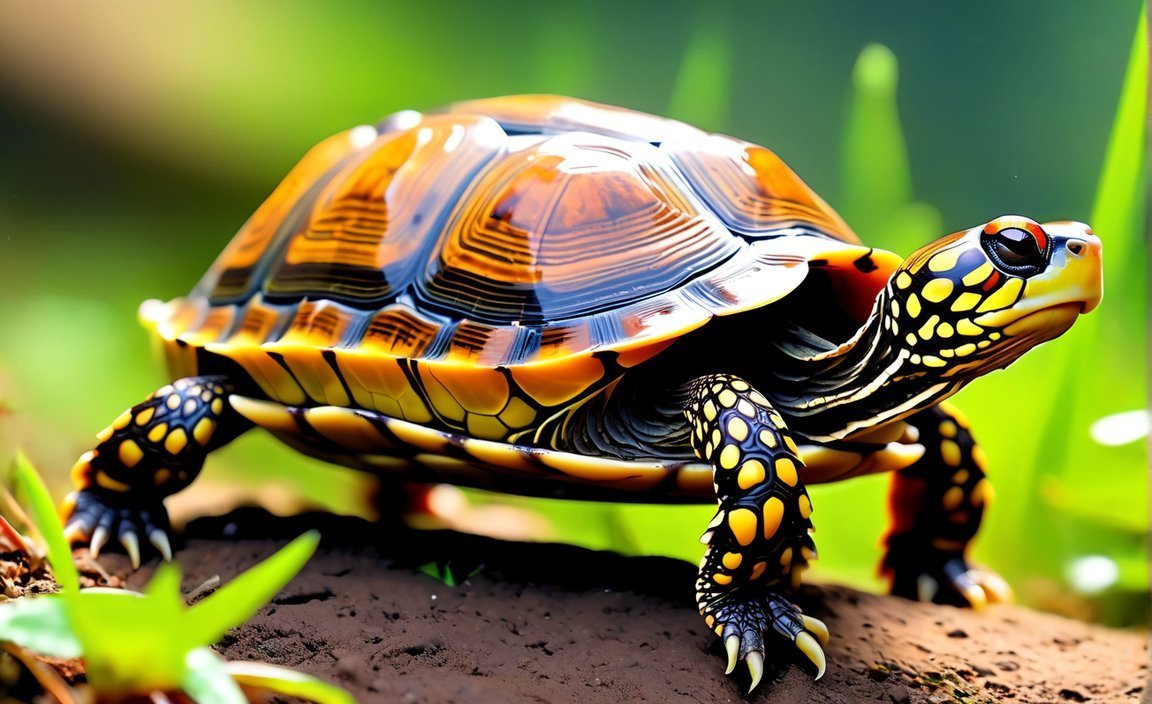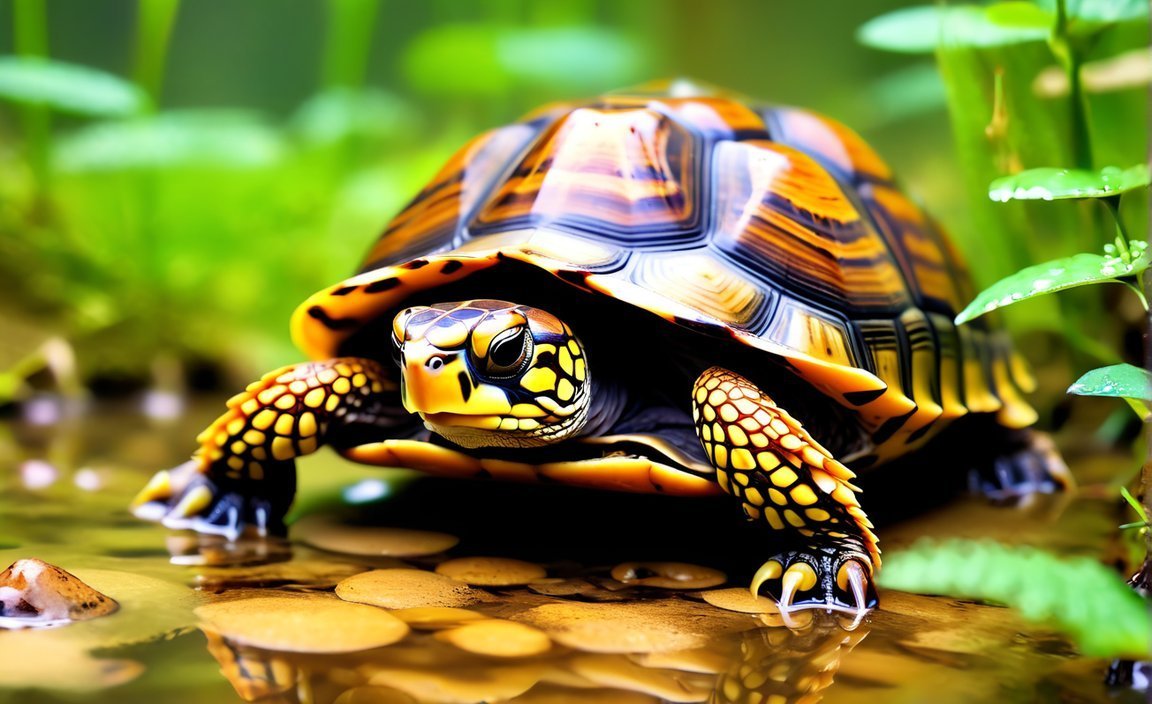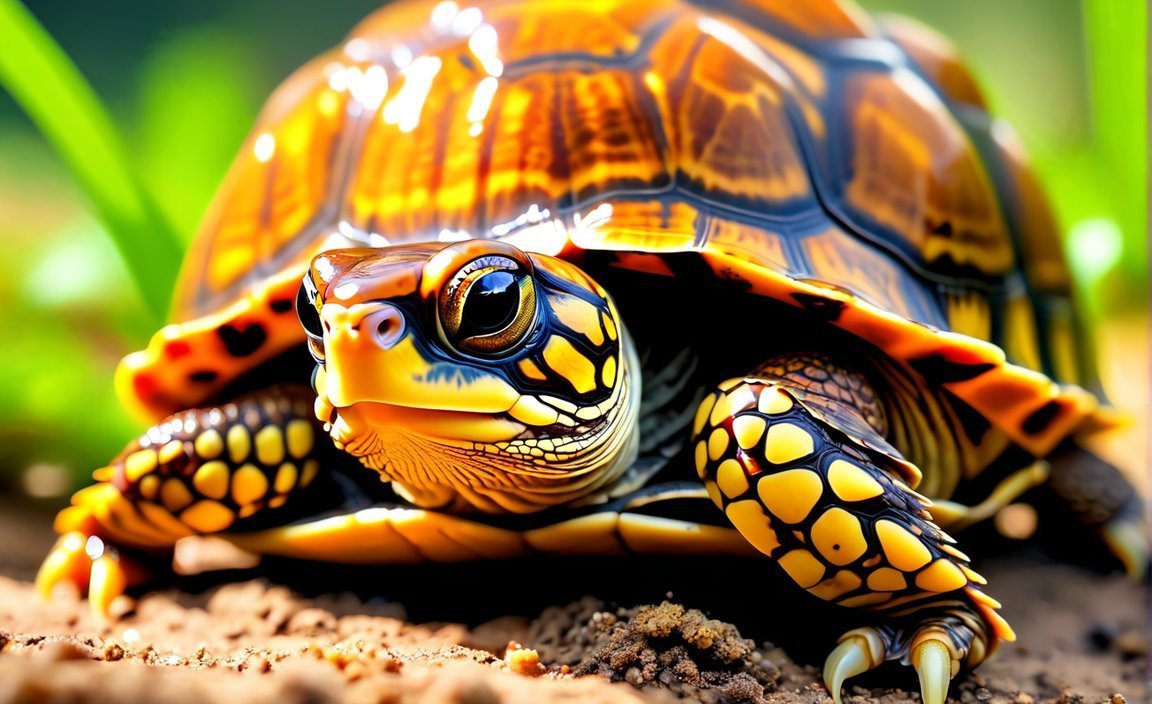Discover 10 Fascinating Box Turtle Facts in Their Natural Habitat. Box turtles, with their intriguing behavior and unique characteristics, have captivated the interest of wildlife enthusiasts and conservationists alike. As these ancient reptiles go about their lives in various habitats, they play a significant role in maintaining the delicate balance of ecosystems. Delve into the world of box turtles as we unveil ten intriguing facts about these remarkable creatures. From their distinct life cycle to their vital contributions to the environment, prepare to be amazed by the wonders of box turtles.

Key Takeaways:
- A box turtle’s shell is attached to its body, specifically by its rib cage.
- Box turtles seek shelter under bushes and trees to stay cool on hot days.
- Crossing roads can be fatal for many box turtles, as they are often run over by passing traffic.
- The territory range of a box turtle is equivalent to a football field.
- Box turtles can grow up to 8 inches in size.
- Their high domed carapace and hinged plastron allow box turtles to almost completely close their shells.
- Most box turtles have tan to brown coloring and are covered with spots, blotches, lines, and bars.
- Male box turtles are generally larger than females.
- Eastern box turtles have been designated as the official reptiles of Tennessee and North Carolina.
- While box turtles typically live for 25-35 years, some individuals have been known to survive over 100 years.
10 Facts About Box Turtles
Box turtles are fascinating reptiles that captivate both scientists and nature enthusiasts alike. These ancient creatures possess unique characteristics and play a significant role in the ecosystem. If you’re curious to learn more about box turtles, here are 10 intriguing facts about them.
1. A Unique Connection
Did you know that a box turtle’s shell is attached to its body through its rib cage? The shell acts as a protective armor, providing vital defense against predators. This strong bond between shell and body allows these turtles to carry their homes wherever they go.
2. Masters of Shady Hideouts
On scorching hot days, box turtles retreat under bushes and trees to find shelter from the relentless sun. They instinctively seek cooler spots to avoid overheating and maintain their body temperature. These resourceful reptiles know how to beat the heat!
3. A Tragic Reality
Tragically, many box turtles meet their doom while attempting to cross busy roads. The slow and deliberate pace of these creatures often puts them at risk of being struck by passing vehicles. Awareness and caution are crucial to protecting these valuable members of our ecosystem.
4. A Limited Territory
Despite their small size, box turtles have an impressive territorial range that can span up to the size of a football field. Within this territory, they find everything they need for survival—food, water, and suitable habitat. They truly make the most of their surroundings!
5. The Bigger, the Better?
Box turtles exhibit slight variations in size, with some individuals growing up to a remarkable 8 inches. These diminutive creatures can make a big impression!
6. A Perfect Fit
Box turtles possess a high-domed carapace or upper shell and a hinged plastron or lower shell. This unique structure allows them to almost completely close their shell when threatened, providing them with excellent protection. It’s like having a built-in fortress!
7. Nature’s Beautiful Canvas
Most box turtles boast stunning patterns on their shells. Ranging in hues from tan to brown, their shells are adorned with spots, blotches, lines, and bars, creating a beautiful and distinct appearance. These markings are as unique as human fingerprints!
8. Gender Differences
In the box turtle world, size matters when it comes to determining gender. Males tend to be larger than females, a common trend among many reptile species. Nature always has its way of distinguishing between the sexes!
9. Symbolic Reptiles
The Eastern box turtle holds a special place in the hearts of Tennessee and North Carolina as it has been designated as their official reptile. These states recognize the significance and beauty of these remarkable creatures, honoring them with this special recognition.
10. Prime Survivors
Box turtles are known for their longevity. While their average lifespan ranges from 25 to 35 years, some individuals have managed to defy all odds and live for over a century! These resilient reptiles have truly stood the test of time.
Now that you’re armed with these 10 fascinating facts about box turtles, you have a deeper understanding of the incredible lives they lead. These ancient reptiles continue to mesmerize us with their unique characteristics and their crucial role within our ecosystem.
Satisfy your curiosity about the natural world by uncovering the intriguing world of box turtles—ten fascinating facts at a time!
Here are some interesting facts about animal shelters: 10 facts about animal shelters. Explore this link to learn more about the incredible work that animal shelters do to provide a safe haven for animals in need.
Do you want to know more about animal welfare? Check out these enlightening facts: 10 facts about animal welfare. Click on the link to discover the importance of animal welfare and how it impacts the lives of animals everywhere.
Are you curious about the role of animal welfare councils? Dive into this link to explore 10 facts about animal welfare council. Find out how these councils play a crucial role in protecting and advocating for the well-being of animals.
If you’re interested in animal facts in Hindi, click on this link for 10 facts about animals in Hindi. Discover fascinating information about animals in the language of Hindi and expand your knowledge in a fun and engaging way.
Want to learn more about the life of a vet? Click here for some intriguing facts about being a vet. Uncover the challenges, rewards, and unique experiences that veterinarians face in their noble profession.
If you’re considering a career as a veterinarian, don’t miss this opportunity to explore 10 facts about being a veterinarian. Click on the link to gain valuable insights into the responsibilities and joys of this meaningful profession.
Discover the thrilling world of dog sled racing with these interesting facts: 10 facts about dog sled racing. From the adrenaline-packed races to the incredible bond between mushers and their dogs, this link will take you on an exciting journey through the heart of this sport.
Are you a dog or a cat lover? Explore this link and uncover intriguing facts about the dynamic relationship between dogs and cats. From their ancient rivalry to heartwarming stories of unlikely friendships, this link will delight and entertain animal enthusiasts of all kinds.
Box Turtles: Fascinating Facts about their Distinctive Shell
Box turtles are captivating creatures with a unique characteristic that sets them apart from other reptiles—their distinctive shell. This shell not only provides them with protection but also offers valuable insights into their behavior, habitat, and the role they play in the ecosystem. Let’s dive into these fascinating facts about box turtles and explore the wonders of their magnificent shells.
1. The Anatomy of Protection
At the core of a box turtle’s defense mechanism lies its distinctive shell. Composed of two parts—the upper carapace and the lower plastron—the shell serves as a fortified fortress. What makes it truly remarkable is its ability to close tightly, allowing the turtle to retreat into its shell and shield itself from predators. This remarkable adaptation affords box turtles a mobile refuge that goes wherever they do, ensuring their safety.
2. A Diverse Range of Turtles
Box turtles are divided into two main groups: Asian box turtles (genus Cuora or Pyxidea) and North American box turtles (genus Terrapene). While both groups share the same fundamental shell structure, each exhibits unique characteristics and traits. Regardless of their geographic origin, all box turtles possess a shell that grants them unparalleled protection.
3. Omnivorous by Nature
Box turtles are opportunistic eaters, showcasing their versatility as both herbivores and carnivores. Their diet encompasses a broad range of foods, including snails, insects, berries, fungi, worms, fish, frogs, and plants. This adaptability enables them to thrive in various habitats by utilizing the available food sources, contributing to the balance of their ecosystems.
4. A Mating Dance of Survival
Mating behavior in box turtles involves one-on-one encounters between males and females. However, there are occasions when two males compete for access to the same female, engaging in a spirited bout to assert their dominance. This intricate dance highlights the competitive nature of box turtles while ensuring the survival of their species through successful reproduction.
5. Conservation Concerns
Both Asian and North American box turtles face threats that endanger their survival. Asian box turtles are at risk of extinction due to capture for the local food markets, while North American box turtles contend with habitat destruction and the capture of hatchlings from the wild. These challenges emphasize the importance of conservation efforts to safeguard these extraordinary creatures and preserve the delicate balance they maintain in their respective ecosystems.
6. The Gift of Longevity
Box turtles are renowned for their longevity, with some individuals living for over 40 to 50 years. Astonishingly, there have been unverified cases of box turtles surpassing the age of 100 years. Their long lifespan enables them to become invaluable members of their habitats, contributing to the delicate ecological dynamics over several decades.
7. Sonic Skills
A recent study conducted by Davidson College discovered an intriguing ability of box turtles—they can produce sounds with their jaws that exceed 75dB. These audible signals serve a dual purpose: scaring away potential predators and acting as a mating call. This newfound knowledge adds yet another layer to the captivating world of box turtles, showcasing their diverse range of adaptation mechanisms.
These fascinating facts shed light on the incredible world of box turtles and the integral role their distinctive shells play in their lives. From offering unparalleled protection and enabling survival to contributing to the harmony of their ecosystems, box turtles and their remarkable shells continue to captivate wildlife enthusiasts and conservationists around the globe.
Key Takeaways:
– Box turtles possess a distinctive shell that provides them with exceptional protection against predators.
– These remarkable shells are composed of two parts—the upper carapace and the lower plastron—and can close tightly, allowing the turtle to retreat to safety.
– Box turtles can adapt their diet based on the available resources, displaying both herbivorous and carnivorous tendencies.
– Their mating behavior involves both one-on-one encounters and occasional male-male competition, ensuring successful reproduction.
– Conservation efforts are crucial to safeguard box turtles, as both Asian and North American species face significant threats.
– Box turtles are known for their longevity, with some individuals living for over 40 to 50 years and even reaching more than 100 years.
– Recent research has revealed that box turtles can produce sounds with their jaws that serve as a defense mechanism and a mating call.
Sources:
– Wikipedia page on Box Turtle
– Study conducted by Davidson College on box turtle communication
Box Turtles: Skilled Navigators of their Home Territory
Box turtles, with their unique abilities, captivate our curiosity and imagination. These ancient reptiles are skilled at finding their way back to their home territory, even in unfamiliar areas. Their homing instinct, combined with their excellent memory and internal compass, allows box turtles to navigate through vast terrain with confidence. In this article, we will explore ten fascinating facts about box turtles that shed light on their exceptional navigation skills and their significant role in the ecosystem.
Fact 1: Box turtles possess an internal compass that guides them
Box turtles have a remarkable ability to navigate through unfamiliar landscapes, thanks to their internal compass. It enables them to confidently traverse vast areas and find their way back home. No matter how far they roam, these turtles instinctively know the direction towards their “home base.”
Fact 2: They utilize their homing instinct to return to familiar areas
Box turtles have a unique homing instinct that sets them apart from other species. This instinctual behavior aids them in finding their way back home, even in unfamiliar territories. They possess an excellent memory and can remember routes to places they have been before, allowing them to navigate long distances with ease.
Fact 3: A box turtle’s home territory is its sanctuary
Box turtles are homebodies, preferring to spend their entire lives in a few acres of land. They establish their home territory, which provides them with the resources and shelter they need to thrive. Picking up and moving a box turtle to a different location is not recommended, as it disrupts their sense of familiarity and can be detrimental to their well-being.
Fact 4: Box turtles can cover impressive distances
Although box turtles are not great travelers, they can still cover considerable distances within their home territory. Eastern box turtles, for instance, can walk energetically with their heads upright and travel about 50 meters in a single day. This showcases their determination and ability to explore their surroundings while always finding their way back.
Fact 5: Box turtles have a secure and permanent shell
The unique and iconic shell of box turtles plays a significant role in their navigation skills. Their shells are a part of their skeleton and are securely attached, preventing them from being easily dislodged or crawled out of. This protective shell allows them to feel safe as they venture out and return to their home territory.
Fact 6: Box turtles are skilled memory masters
One of the most fascinating aspects of box turtles’ navigation skills is their exceptional memory. These reptiles have the ability to remember places they have been to before. This remarkable memory, combined with their homing instinct, enables them to consistently find their way back to familiar locations, ensuring their survival within their home territory.
Fact 7: The territorial range of box turtles is limited
Box turtles typically establish a territorial range that spans only a few acres, similar to their home territory. They prefer to stay within this limited area that provides them with all the necessary resources for survival. Their small-scale navigation skills contribute to their adaptability and success in their immediate environment.
Fact 8: Box turtles exhibit caution when it comes to travel
Unlike some other turtle species, box turtles are not avid travelers. They have a natural inclination to stay within their home territory and avoid unnecessary movements. This cautious behavior ensures they conserve energy and reduce the risk of encountering unfamiliar and potentially dangerous situations.
Fact 9: The implications of disrupting a box turtle’s home territory
Moving a box turtle to a different location can have severe consequences. It disrupts their sense of familiarity and disorients them. This displacement can negatively impact their ability to find their way back home, leading to increased vulnerability and potential harm. As responsible conservationists, it is crucial to respect and preserve a box turtle’s home territory.
Fact 10: Box turtles play a vital role in their ecosystem
Box turtles have an essential role within their ecosystem. As omnivorous creatures, they help maintain ecological balance by consuming a variety of foods and dispersing seeds through their droppings. Their navigation skills ensure that they effectively carry out their ecological duties within their home territory.
Key Takeaways:
- Box turtles possess an internal compass, enabling them to navigate through unfamiliar terrain.
- Their homing instinct helps them find their way back to their home territory, even in unfamiliar areas.
- Box turtles establish a limited home territory where they spend their entire lives.
- Moving a box turtle disrupts their sense of familiarity and should be avoided.
- Box turtles can cover impressive distances within their home territory, but they are not great travelers.
- The secure and permanent shell of box turtles contributes to their navigation skills.
- Box turtles have remarkable memory capabilities and can remember places they have been to before.
- Their small-scale navigation skills and limited territorial range contribute to their adaptability.
- Disrupting a box turtle’s home territory can have severe consequences for their survival and well-being.
- Box turtles play a vital role in their ecosystem by consuming various foods and dispersing seeds.
Sources:
1. Davidson College Study: Box turtles can make sounds with their jaws
2. National Wildlife Federation: Box Turtles
Box Turtles: The Unsung Heroes of the Ecosystem
Box turtles play a vital role in their ecosystem as seed dispersers and predators of pests.
Box turtles are not just fascinating creatures with unique characteristics, but they also hold an important position in the delicate balance of their ecosystem. In addition to their longevity and ability to adapt to different habitats, they contribute significantly to the health and diversity of their surroundings. Let’s delve into the intriguing facts about box turtles and their crucial role in the ecosystem.
Key Takeaways:
- Turtles, including box turtles, are essential for seed dispersal in terrestrial ecosystems[^1^].
- Box turtles, such as Terrapene carolina, have been identified as potential agents for seed dispersal[^1^].
- They help control populations of insects and small animals, playing an important role in maintaining overall biodiversity[^2^].
- The seeds that pass through the digestive tracts of box turtles have higher germinability, which aids in seedling establishment[^2^].
- Turtles have been recognized as key seed dispersers in various ecosystems, known as chelonochory[^1^].
- By dispersing seeds, box turtles contribute to the growth and diversity of plant communities, ensuring a healthy ecosystem.
Now, let’s dive deeper into these fascinating facts!
1. Seed Dispersal: A Crucial Function
Box turtles are integral to seed dispersal in terrestrial ecosystems. Their role as seed dispersers has been extensively studied in both completely terrestrial species and box turtles themselves[^1^]. They aid in the dispersal of seeds by consuming various fruits and vegetation, and then depositing the seeds away from the source plant through their digestive processes.
2. Promoting Germination and Seedling Establishment
The passage of seeds through the digestive tracts of box turtles has a positive impact on seedling establishment. It enhances the germinability of seeds and ensures their deposition at a distance from the parent plant[^2^]. This process plays a vital role in the growth and expansion of plant populations, ultimately contributing to the overall health of the ecosystem.
3. Controlling Insect and Small Animal Populations
Box turtles are not only seed dispersers but also predators of pests. These omnivorous reptiles help control populations of insects and small animals, thus maintaining a balance within the ecosystem[^2^]. By keeping such populations in check, box turtles indirectly contribute to the overall health and stability of the environment.
4. Chelonochory: The Turtle Seed Dispersal Process
The term “chelonochory” refers to the phenomenon of seed dispersal by turtles. Across various ecosystems, turtles have been identified as key seed dispersers[^1^]. They consume seeds and fruits, and through their digestive processes, facilitate seed dispersal. This process enables the growth and propagation of different plant species and enhances the overall biodiversity of the ecosystem.
5. Contributing to Ecosystem Health
Due to their unique feeding habits and seed dispersal abilities, box turtles play a crucial role in maintaining the health of their habitat. By controlling insect and small animal populations, they prevent potential imbalances that could disrupt the ecosystem[^2^]. Their contribution ensures the optimal functioning and sustainability of the environment they inhabit.
6. Conservation and Preservation Efforts
Considering the vital role box turtles play in their ecosystem, it becomes imperative to focus on their conservation and preservation. Protecting their habitat, educating the public about their ecological significance, and implementing measures to mitigate threats are crucial steps towards ensuring the long-term survival of box turtles and the health of the ecosystems they inhabit.
In conclusion, box turtles are not just fascinating creatures, but vital contributors to the balance and well-being of their ecosystem. Their role as seed dispersers and predators of pests keeps the environment healthy and diverse. By understanding and appreciating their unique characteristics and ecological significance, we can work towards their conservation and ensure the preservation of the delicate web of life they are a part of.
Sources:
[^1^]: Karraker, N. E., Kusrini, M. D., Atutubo, J. R., Healey, R. M., & Yusratul, A. (2020). Non‐marine turtle plays important functional roles in Indonesian ecosystems. Ecology and Evolution, 10(18), 9613-9623. Link to article
[^2^]: Braun, J. (1985). Box Turtles, Terrapene carolina, as Potential Seed Dispersers: Effects of Passage Through Digestive Tracts on Seed Germination. Dissertations, Theses, and Masters Projects. Link to article

FAQ
Q1: What are box turtles’ primary habitats?
A1: Box turtles prefer to stay under bushes and trees to keep cool on hot days. They can be found in a range of territories equal to a football field.
Q2: How big do box turtles grow?
A2: Box turtles can grow to a size of up to 8 inches.
Q3: How can box turtles protect themselves from predators?
A3: Box turtles have a unique shell shape that allows them to close their shell tightly, providing them with protection against predators.
Q4: How long do box turtles generally live?
A4: On average, box turtles live for 25-35 years, but some individuals have been known to survive for over 100 years.
Q5: What are the potential risks to box turtles?
A5: Box turtles face various threats such as road mortality due to vehicle collisions while attempting to cross roads, habitat destruction, and capture of hatchlings from the wild. Asian box turtles are also in danger of extinction due to capture for local food markets.
















